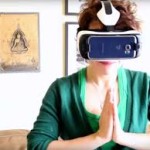
Virtual reality meditation is showing signs of becoming a new popular form of meditation. It uses technology to add a new dimension to the approaches of visualization and guided imagery. Machines, apps and software are augmenting what used to be a solely internal process. Does it work?
Before I answer the question of does it work I will give you a little background of the two major approaches to meditation. I had a teacher many years ago who used to refer to these two kinds of meditation as “top down” and “bottom up”. There are a lot of ways to explain this concept but I think the simplest is to say that “top down” refers to connecting deeply with the body and the present moment and “bottom up” refers to disconnecting from the body and exploring other ways of being. They are both very valid ways of being and there is a lot to be experienced by embracing both. There is actually a third approach that combines “top down” and “bottom up” but I don’t see it being taught very much and I suspect it has become a rarity in today’s approaches to ways of being.
Visualization and guided imagery whether done the old fashioned way or the virtual reality way works. There is some science behind it but not yet nearly as much as behind the “top down” approach. Most of the “bottom up” science is in the field of stress reduction and relaxation and a little bit in the sports performance field. I think it is a hard approach to define because many of the results are very subjective outside the fields I mentioned. There are some old traditions that have made detailed studies of these “altered states” but inevitably they are limited to the flavor of that particular tradition. There are literally an infinite number of experiences to be had this way. I have noticed that in many cases the beneficial results that have been measured tend to be temporary. It’s “as if” they haven’t really “sunk in”. I also think that the virtual reality meditation approach would be even more temporary as it by-passes the inner work and discipline necessary to do it without the various aids. Nonetheless if that is the kind of experience you want then it definitely works.
“Top down” meditation has been researched extensively over the past 30 years and is driving the phenomenal popularity of mindfulness meditation. It too has been around for a long time and has always existed alongside “bottom up”. We are seeing research in the fields of physical, mental, emotional and spiritual well being that is suggesting that there is a much broader way that we can experience our lives in a very positive way. As science develops more ways to measure things that until recently were unmeasurable we will continue to learn what our potential to experience really is.
In conclusion I would like to recommend that if you want to explore the “bottom up” approaches that you first learn “top down”. For people living a non monastic life and/or without an experienced teacher there seems to be a tendency that without the “grounding” of the present moment experience, the “bottom up” experiences can create some disorientation. It may not be noticeable at first but it eventually seems to have that effect for many people. As I mentioned before, if you still are interested in the “bottom up” approaches, my preference is to first get firmly entrenched in the here and now.
